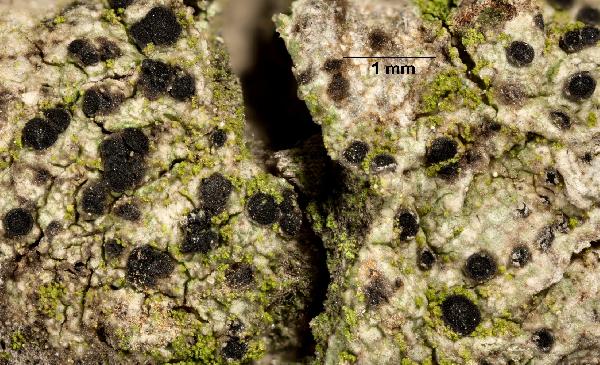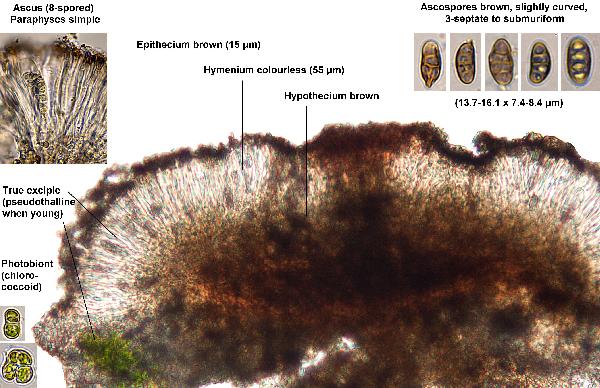Diplotomma pharcidium (Ach.) M. Choisy
Bull. mens. Soc. linn. Soc. Bot. Lyon, 19: 156, 1950. Basionym: Lecanora pharcidia Ach. - Syn. Meth. Lich.: 147, 1814.
Synonyms: Buellia alboatra var. athroa (Ach.) Th. Fr.; Buellia pharcidia (Ach.) Malme; Diplotomma athroum (Ach.) Kernst.; Diplotomma zaboticum Körb.; Lecanora pharcidia Ach.; Lecidea parasema var. athroa Ach.
Distribution: N - TAA (Dalla Torre & Sarnthein 1902), Emil (Fariselli & al. 2020).
Description: Thallus crustose, episubstratic, rather thick, areolate to verrucose-areolate, whitish, grey, or rarely pale brown, often delimited by a dark prothalline line. Medulla white, I-. Apothecia lecideine, black, epruinose or slightly pruinose, 0.3-1(-1.5) mm across, initially immersed, then more or less sessile, with a black, flat to convex disc, a thick proper margin, and a pseudothalline margin which is more evident in young apothecia. Proper exciple up to 75 µm wide laterally, brown in outer part, colourless to pale brown in inner part, of radiating hyphae, extending below the hypothecium; epithecium brown; hymenium colourless, not inspersed with oil droplets, 75-100 μm high, K/I+ blue; paraphyses simple, c. 2 μm thick at mid-level, the apical cells slightly capitate, up to 3 μm wide; hypothecium brown. Asci 8-spored, clavate to cylindrical-clavate, the apical dome K/I+ dark blue with a pale, conical-pointed apical cushion (axial mass), the wall I-, but the thin outer gel I+ blue, approaching the Bacidia-type. Ascospores 3-septate, sometimes with a single longitudinal septum in central part, on either side of the middle transverse septum, brown, ellipsoid, 14-25 x 8-11 µm. Pycnidia rare, the wall brown in upper part, colourless in lower part. Conidia bacilliform, 7-10 x c. 1 µm . Photobiont chlorococcoid. Spot tests: K-, C-, KC-, P-, UV-. Chemistry: without lichen substances.Note: mostly on the smooth bark of deciduous trees, much more rarely on lignum, at relatively low elevations. According to Roux & coll. (2014) this is a good species, differing from D. alboatrum in the larger apothecia with a thick margin. The sample from Emilia, identified by H. Sipman, was collected by V.J. Grummann near the Beach of Savio, on Platanus.
Growth form: Crustose
Substrata: bark
Photobiont: green algae other than Trentepohlia
Reproductive strategy: mainly sexual
Commonnes-rarity: (info)
Alpine belt: absent
Subalpine belt: absent
Oromediterranean belt: absent
Montane belt: absent
Submediterranean belt: very rare
Padanian area: absent
Humid submediterranean belt: absent
Humid mediterranean belt: very rare
Dry mediterranean belt: absent

Predictive model

Harrie Sipman – Source http://www.bgbm.fu-berlin.de/sipman/Zschackia/AegeanLichens/CaloplacaAC.htm - As Caloplaca oasis
Growth form: Crustose
Substrata: bark
Photobiont: green algae other than Trentepohlia
Reproductive strategy: mainly sexual
Commonnes-rarity: (info)
Alpine belt: absent
Subalpine belt: absent
Oromediterranean belt: absent
Montane belt: absent
Submediterranean belt: very rare
Padanian area: absent
Humid submediterranean belt: absent
Humid mediterranean belt: very rare
Dry mediterranean belt: absent

Predictive model

 Index Fungorum
Index Fungorum
 GBIF
GBIF



